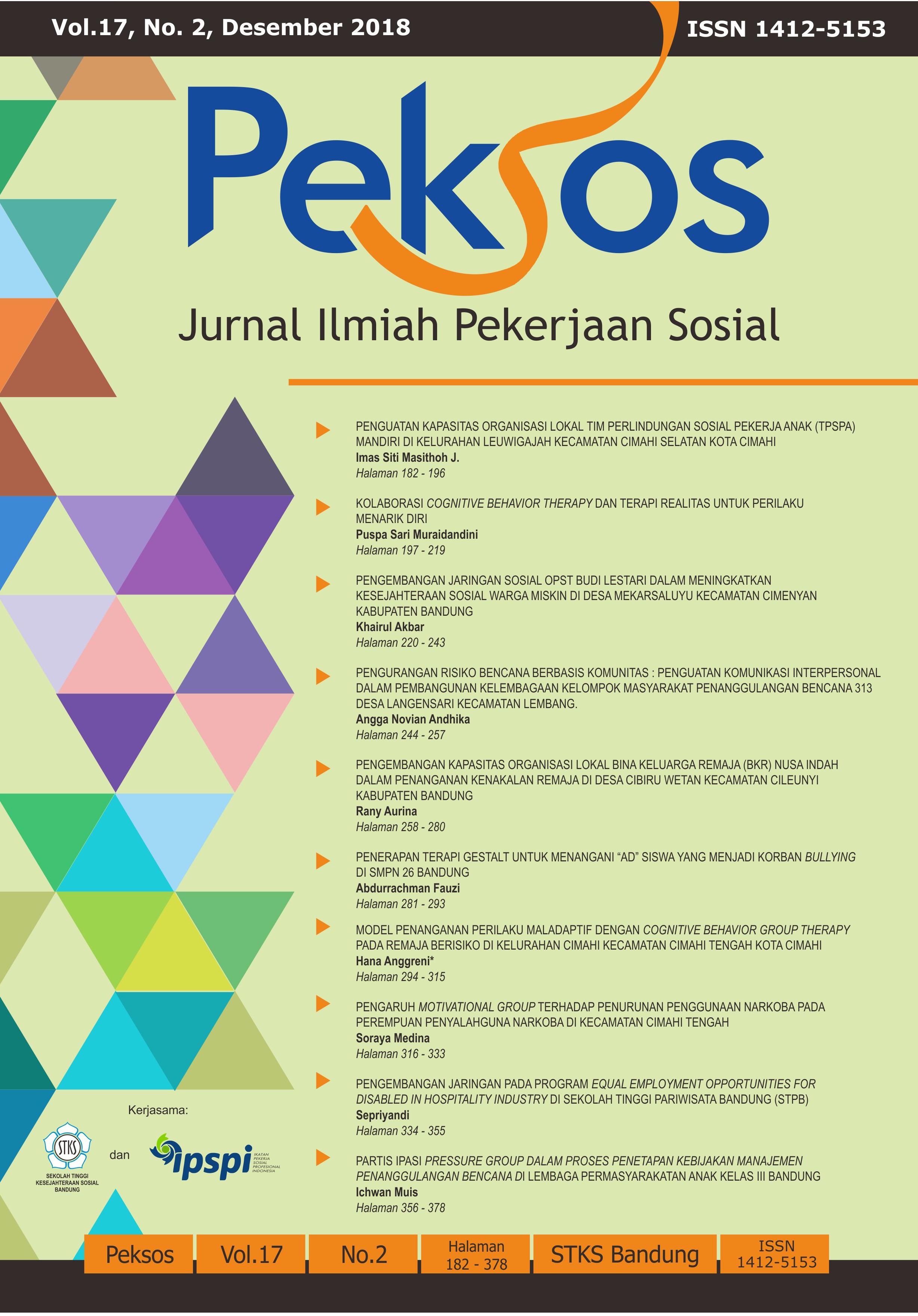Quality of Life of Non-Cash Food Assistance Beneficiary Families in Gedangsewu Village, Boyolangu Subdistrict, Tulungagung Regency
DOI:
https://doi.org/10.31595/peksos.v23i2.1416Keywords:
Quality of Life, Beneficiary Families, BPNT ProgramAbstract
Quality of life refers to an individual's perception of their position in life within the context of the culture and value systems in which they live, and their relationship to their goals, expectations, standards, and concerns. This study aims to empirically capture: 1) respondent characteristics, 2) physical health, 3) psychological conditions, 4) social relationships, and 5) the environment of Non-Cash Food Aid (BPNT) recipient families. The method used is a survey method with a descriptive approach. The sampling technique employed is Simple Random Sampling. Data collection techniques used are: 1) questionnaires and 2) documentation studies. The validity and reliability tests of the measuring instruments in this study used readability tests, face validity, and SPSS analyzed with descriptive statistics. The study results on 56 BPNT recipient families showed that the quality of life of the recipients falls into the medium category, with a total score ranging from 50 to 75. Based on the study results, the recipients are aware of the importance of maintaining physical health, have very close social relationships, good social support, and a comfortable environment. However, problems were identified in psychological conditions, marked by frequent negative feelings, rarely feeling happy, dissatisfaction with enjoying life, and infrequent opportunities for fun or recreation. Financial uncertainty, lack of income, and debt burdens can cause psychological stress for the recipients. The researchers propose a Quality of Life Improvement Program for recipient families through the Joint Business Group (KUBE) Catfish Farming with the Biofloc System. This program uses the group work method with a recreation skill group type. The strategy employed is collaboration, and the technique used is capacity building.
Downloads
References
Adi, Fahrudin. Pengantar Kesejahteraan Sosial. Rafika Aditama, 2014.
Appulembang, and Dewi. “Pengembangan Alat Ukur Quality of Life Urban Community.” Jurnal Muara Ilmu Sosial, Humaniora, dan Seni, 2017. https://doi.org/10.24912/jmishumsen.v1i1.363
Badan Pusat Statistik. Profil Kemiskinan di Indonesia Maret 2023, 2023.
Mulyono, Edy S. Kemiskinan & Pemberdayaan Masyarakat. Yogyakarta: Penerbit Ombak, 2017.
Peraturan Menteri Sosial Nomor 11 Tahun 2018 tentang Penyaluran Bantuan Pangan Non Tunai
Sugiyono. Metode Penelitian Kuantitatif, Kualitatif dan R&D. Bandung: PT Alfabet, 2016.
Sumintono, Bambang, and Widhiarso. “Aplikasi Model Rasch untuk Penelitian Ilmu-Ilmu Sosial.” Trim Komunikata Publishing House, 2014.
Tim Pengendali Pelaksanaan Penyaluran Bantuan Sosial Secara Non Tunai. Pedoman Umum Bantuan Pangan Non Tunai 2019, 2019.
Utomo, Dedy. “Pelaksanaan Program Keluarga Harapan Dalam Meningkatkan Kualitas Hidup Rumah Tangga Miskin (Studi Pada Unit Pelaksana Program Keluarga Harapan Kecamatan Purwoasri Kabupaten Kediri).” Jurnal Administrasi Publik Mahasiswa Universitas Brawijaya, 2014. https://administrasipublik.studentjournal.ub.ac.id/index.php/jap/article/view/333
World Health Organization. WHOQOL User Manual. Division of Mental Health and Prevention of Substance Abuse, 2012.
WHOQOL-BREF: Introduction, Administration, Scoring and Generic Version of The Assessment: Field Trial Version https://www.who.int/publications/i/item/WHOQOL-BREF
Zastrow, Charles H. Introduction to Social Work and Social Welfare: Empowering People. 12th ed., Cengage Learning, 2017.
Downloads
Published
How to Cite
Issue
Section
Citation Check
License
Copyright (c) 2024 Maulana Herviansyah, Dwi Yuliani, Ayii Haryani

This work is licensed under a Creative Commons Attribution-NonCommercial-ShareAlike 4.0 International License.
Author(s) who published in this journal agree to following terms:
- Author(s) must understand and agree that the copyright script in published owned by the Peksos: Jurnal Ilmiah Pekerjaan Sosial. The copyright includes reproducing and selling the manuscript to all parties.
- Everyone can cite every manuscript published in Peksos: Jurnal Ilmiah Pekerjaan Sosial for educational purposes, with the author's name and the Peksos: Jurnal Ilmiah Pekerjaan Sosial on reference.









